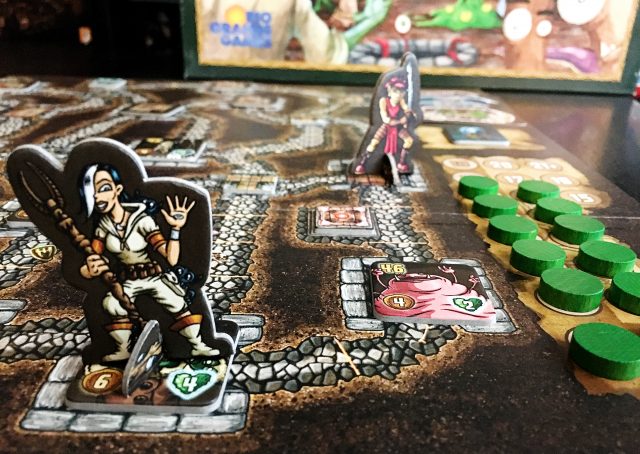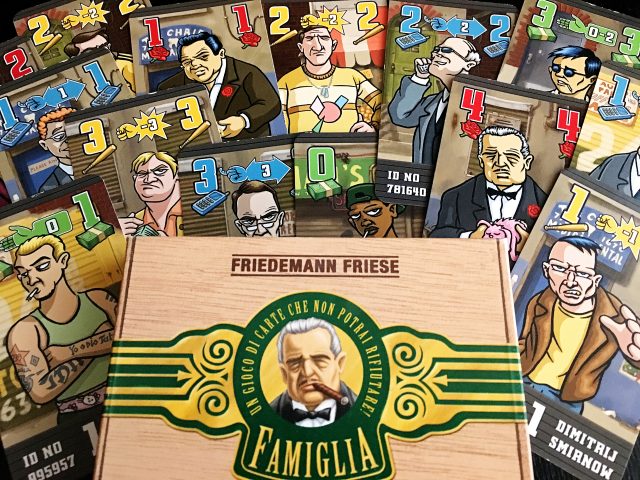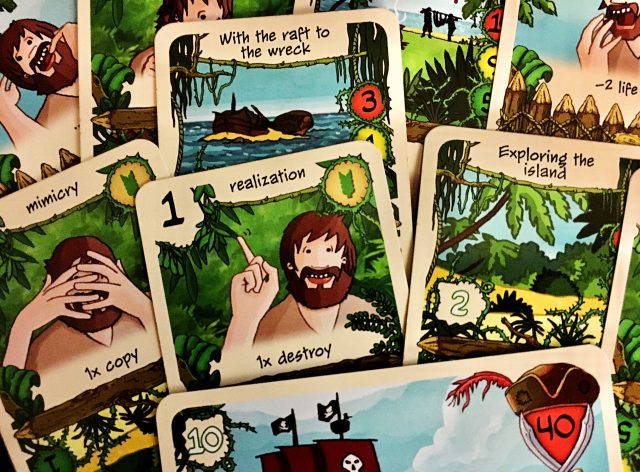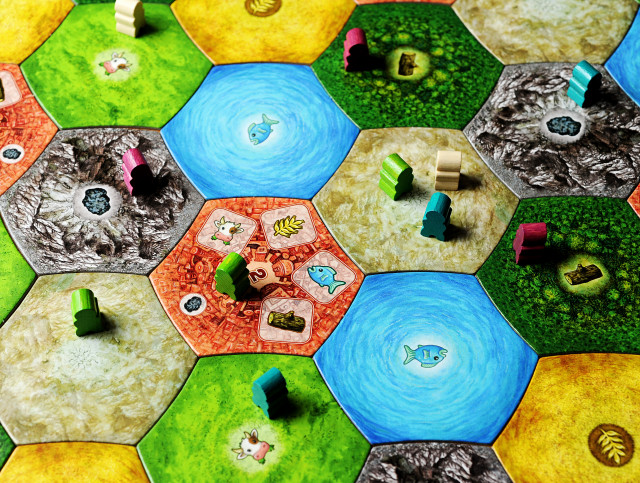Few designers can claim to have such a distinctive look to their games, as Friedemann Friese. His habit of starting the names of his games (in both German and English) with the letter “f”, and the visual stamp of his decades-long partnership with Lars-Arne “Maura” Kalusky make it very easy to pick out an “FF” game on FLGS shelves. Not to mention his shock of punk-green hair.
 But Friese’s unified graphic sensibility belies an ambitious sweep of themes and mechanics, and he’s as well-known for meaty and Euro-y games as he is for his lighter, more whimsical games. Plus, as we shall see, he is not afraid of deconstructing the very nature of games themselves, exposing the inner workings a la Paris’ Centre Pompidou.
But Friese’s unified graphic sensibility belies an ambitious sweep of themes and mechanics, and he’s as well-known for meaty and Euro-y games as he is for his lighter, more whimsical games. Plus, as we shall see, he is not afraid of deconstructing the very nature of games themselves, exposing the inner workings a la Paris’ Centre Pompidou.
Here then are a baker’s-dozen highlights of Friese’s twenty-five year (and counting) career of games:
Landlord (1992): Friese’s first big success, Landlord was reissued in 2013, a tribute to the the ongoing appeal of this card game with plenty of in-your-face take-that play where you get to be a slumlord trying to build the biggest apartment blocks, attract the best tenants, and maybe stick a few surreptitious sticks of dynamite in your opponents’ buildings just to maintain your lead. Friese was 22 when Landlord came out, and I wonder if it reflected his own experiences and frustrations with his living conditions.
Power Grid (2001): The decade following Landlord saw Friese design several midweight games (2000’s Turbo Taxi is probably the best-known and still in print) but it was Power Grid (Funkenschlag in its original German incarnation) that put Friese solidly on the map in more ways than one. With a theme of electrical generation, you wouldn’t think a game like this would prove so popular, and you’d be wrong. Friese combines auction, resource and money management, and network-building into a tight and exciting game. Players must walk a tightrope of expansion and consolidation, maneuvering in turn order, and timing your resource and linkage purchases. While the original board was two-sided with maps of Germany and the US, there have been numerous official and innumerable fanmade map expansions of places real and fictional. Though the rules and gameplay can be confusing to newcomers, Power Grid continues to command allegiance, currently sitting at 26 on the BGG overall rankings. Friese has not been afraid to revisit his early masterpiece with reimplementations as well as modules covering stocks, AI bots, and even legacy-style campaign play.
Fearsome Floors (2003): This game is the middle of a trilogy which is bookended by Fische Fluppen Frikadellen and Formidable Foes (see below), sharing a common delving/horror theme. Fearsome Floors takes a more tactical approach as players each race to get their four explorers out of the dungeon before it collapses over their heads after fourteen turns. This is complicated by the mostly-but-not-quite-predictable behaviour of the Monster, which has a tendency to eat people.
Funny Friends (2005): Friese essentially takes The Game of Life and Careers and updates them for the 21st century. Starting as a teenager you play cards which increase or decrease various stats trying to stay happy, healthy, and wise. The game is fun and definitely more contemporary in outlook and design than its Parker Brothers ancestors. At a time when social media was just taking shape, the game included some clunky rules around cell phone use. Definitely had some promise, but probably too complicated for the party crowd and too light and random for the Euro fanpeople.
 Formidable Foes (2006): The final game in the “FFF trilogy” (see above), Formidable Foes is a resource-management Euro designed as a dungeon crawl. As with the Legends of Andor series, if you play it as a fantasy RPG, you will lose. So if you’re ok with a puzzly thinky game with a light sprinkling of delving theme (and, in the case of Formidable Foes, charmingly off-beat artwork from Kalusky), this game is up your alley. But if you’re looking for an RPG-lite experience, look elsewhere.
Formidable Foes (2006): The final game in the “FFF trilogy” (see above), Formidable Foes is a resource-management Euro designed as a dungeon crawl. As with the Legends of Andor series, if you play it as a fantasy RPG, you will lose. So if you’re ok with a puzzly thinky game with a light sprinkling of delving theme (and, in the case of Formidable Foes, charmingly off-beat artwork from Kalusky), this game is up your alley. But if you’re looking for an RPG-lite experience, look elsewhere.
Fauna (2008): Friese has a sideline in what I would call “strategic trivia games”, of which Fauna was the first. I like this genre (which includes the very popular Wits & Wagers franchise) because it’s more about using estimation skills and leveraging your friends’ trivia abilities than being an effing know-it-all. Fauna’s board is a map of the world divided into Risk-like regions plus some numeric tracks. Each round a card is drawn picturing a particular species of animal; players take turns placing cubes on the board with their best guesses as to height, weight, tail length, and place of origin. No number or region can be guessed twice, and you are also awarded points for being near the ultimately-revealed right answers. Fauna works as educational tool, family game, or light filler, and if the animal theme doesn’t move you you can try Terra for geography or America for, well, America.
 Famiglia (2010): Coming in a deckbox resembling a box of cigars, this is a two-player card drafting game (a solitaire variant is also available) with an underworld theme–underworld as in crime, not Greek Mythology or Stranger Things. Each of the suits in the four-suited deck has a special ability, and your challenge is to combo the abilities more quickly and efficiently than your opponent. Your score at the end of the game is the value of the cards in your tableau. The artwork (classic Kalusky) certainly plays up to all the common crime stereotypes, and there are at least two Easter Eggs hidden in the cards.
Famiglia (2010): Coming in a deckbox resembling a box of cigars, this is a two-player card drafting game (a solitaire variant is also available) with an underworld theme–underworld as in crime, not Greek Mythology or Stranger Things. Each of the suits in the four-suited deck has a special ability, and your challenge is to combo the abilities more quickly and efficiently than your opponent. Your score at the end of the game is the value of the cards in your tableau. The artwork (classic Kalusky) certainly plays up to all the common crime stereotypes, and there are at least two Easter Eggs hidden in the cards.
 Friday (2011): If I logged my digital plays, Friday might just be the game I’ve played the most, ever. And the app version only came out in mid-2017! But even before that Friday was one of my favorite solitaire games and the first one where I feel Friese set himself a design task and then went about creating the game–a tendency which has grown with time (see below). In this case, he wanted to see if he could design a solo deckbuilding game. Playing as Robinson Crusoe, you must survive three waves of challenges and finally meet and beat two boss levels of randomly-chosen pirates. Instead of buying cards from a market, you add new cards to your deck by besting challenges from the Hazard deck; once beaten, the card turns 180o and joins your deck, adding its fighting value as well as possibly a special power that allows you to manipulate cardplay as you go. Friese ingeniously builds in rules that ratchet up the difficulty as you progress through the waves, from increased challenge values to adding in super-annoying “aging” cards from a separate deck which sap your powers. And if the aging deck empties, it’s game over, man, game over. Friday is portable, playable at several difficulty levels, and just so much fun to play, I can’t recommend it enough. Friese returned to the solo genre with the recent release of Finished!, which is about getting your deck all sorted before you run out of coffee and fall asleep (I can’t make this stuff up). I’ve only played it a couple of times so far, so time will tell if it will join Friday in my “desert island” collection.
Friday (2011): If I logged my digital plays, Friday might just be the game I’ve played the most, ever. And the app version only came out in mid-2017! But even before that Friday was one of my favorite solitaire games and the first one where I feel Friese set himself a design task and then went about creating the game–a tendency which has grown with time (see below). In this case, he wanted to see if he could design a solo deckbuilding game. Playing as Robinson Crusoe, you must survive three waves of challenges and finally meet and beat two boss levels of randomly-chosen pirates. Instead of buying cards from a market, you add new cards to your deck by besting challenges from the Hazard deck; once beaten, the card turns 180o and joins your deck, adding its fighting value as well as possibly a special power that allows you to manipulate cardplay as you go. Friese ingeniously builds in rules that ratchet up the difficulty as you progress through the waves, from increased challenge values to adding in super-annoying “aging” cards from a separate deck which sap your powers. And if the aging deck empties, it’s game over, man, game over. Friday is portable, playable at several difficulty levels, and just so much fun to play, I can’t recommend it enough. Friese returned to the solo genre with the recent release of Finished!, which is about getting your deck all sorted before you run out of coffee and fall asleep (I can’t make this stuff up). I’ve only played it a couple of times so far, so time will tell if it will join Friday in my “desert island” collection.
Copycat (2012): The next milestone in Friese’s “let’s design a game” series really takes it to the max, with the name giving it away. It also sports a cover with an unashamed Obama homage, which may not have helped sales in red states. Friese’s stated purpose was to create a game which combined the tropes of some of the most popular games of the time: deckbuilding, worker placement, and card drafting (with just a hint of Puerto Rico’s put-a-coin-on-unselected-actions). The result is an intriguing and entertaining game with a pasted-on theme of bureaucratic fief-building. Copycat is not one of Friese’s more beloved games but I admire its audacity.
 504 (2015): I don’t think anyone thought Friese could take the deconstructive approach of Copycat any further. Boy, did he prove us wrong. The name of the game refers to the number of different ways there are to play it. Remember those books from when you were a kid, with flaps cut across the pages so you could have the head of one monster, the torso of another, and the legs and feet of a third? 504 takes that idea and instead of body parts uses game mechanics. Each one can be used either as the central mechanism of the game, the secondary mechanic, or the income-generation system. Since there are nine choices in all, the total number of possibilities is 9 x 8 x 7 or 504. One could literally pick a different option every week and not be done for almost ten years–and I am sure there is a gaming group out there somewhere trying literally to do that. Critics acknowledged the gargantuan effort to make it all work, but felt that it took too much effort for players to stitch the various rulesets together, that not every combination resulted in a good game, and that without a compelling theme the games were mere exercises. Others responded by producing digital assistants that made the rule-stitching process much easier and by sharing and compiling lists of the best variations–though unfortunately there is no one place to look. The sheer scope of 504 is breathtaking to me–it’s almost a workshop in game design all by itself.
504 (2015): I don’t think anyone thought Friese could take the deconstructive approach of Copycat any further. Boy, did he prove us wrong. The name of the game refers to the number of different ways there are to play it. Remember those books from when you were a kid, with flaps cut across the pages so you could have the head of one monster, the torso of another, and the legs and feet of a third? 504 takes that idea and instead of body parts uses game mechanics. Each one can be used either as the central mechanism of the game, the secondary mechanic, or the income-generation system. Since there are nine choices in all, the total number of possibilities is 9 x 8 x 7 or 504. One could literally pick a different option every week and not be done for almost ten years–and I am sure there is a gaming group out there somewhere trying literally to do that. Critics acknowledged the gargantuan effort to make it all work, but felt that it took too much effort for players to stitch the various rulesets together, that not every combination resulted in a good game, and that without a compelling theme the games were mere exercises. Others responded by producing digital assistants that made the rule-stitching process much easier and by sharing and compiling lists of the best variations–though unfortunately there is no one place to look. The sheer scope of 504 is breathtaking to me–it’s almost a workshop in game design all by itself.
Power Grid: The Card Game (2016): Despite appearances and the inevitable “Oh, a card game version of a classic board game, how original…” reaction it produces, PG:TCG defies expectations by being cracking good all on its ownsome with the same overall theme and some of the same mechanics, but leveraging the card-play for all its worth through changes in the rules for the power plant auctions and the market for resources. Resources now appear on cards and appear randomly, so their availability is much more unpredictable than in the board game and makes your position in turn order even more important, if possible. The entire geographic network-building component is gone, but interestingly enough I don’t miss it as much as I thought I would, plus it reduces the game’s table-footprint considerably. Kudos to Friese for not taking an easy way out and instead making PG:TCG stand on its own.
 Fuji Flush (2016): 2016 was indeed The Year of the Deck for Friese, with several card-play releases. While Power Grid: The Card Game was for the gamer crowd (see above) and Fabled Fruit took on the legacy game format (see below), Fuji Flush was a straightforward light filler game with climber-like mechanics for up to eight players. The object: to get rid of all your cards. Players go around the table playing cards out of their hands. If yours is still in front of you by the time play gets back to you, you now have one fewer card in hand. But if someone plays a higher card than you in the meantime, you have to “flush” it and draw a new one to replace it. You can also choose to play the same value as the player(s) immediately before you in turn order, which stacks the values and makes it that much less likely you will have to flush. Simple, elegant, and fun.
Fuji Flush (2016): 2016 was indeed The Year of the Deck for Friese, with several card-play releases. While Power Grid: The Card Game was for the gamer crowd (see above) and Fabled Fruit took on the legacy game format (see below), Fuji Flush was a straightforward light filler game with climber-like mechanics for up to eight players. The object: to get rid of all your cards. Players go around the table playing cards out of their hands. If yours is still in front of you by the time play gets back to you, you now have one fewer card in hand. But if someone plays a higher card than you in the meantime, you have to “flush” it and draw a new one to replace it. You can also choose to play the same value as the player(s) immediately before you in turn order, which stacks the values and makes it that much less likely you will have to flush. Simple, elegant, and fun.
Fabled Fruit (2016): Friese obviously looked at the popularity of Pandemic Legacy and wanted in on the trend–but he hated the idea of ripping up cards and being unable to reset the game state. The result was Fabled Fruit, using his so-called “Fable” system. The theme is making smoothies, so very kid-friendly but maybe lacking in tension compared to saving the world from contagious diseases? Gameplay is card-driven mixed with resource management and action selection. On your turn, you place your cute animeeple on a pile of Location cards and either do the action at that Location or use your collected fruits to buy the card, which becomes a Juice. The first player to mix a set number of Juices wins. The Fable System comes in as piles of Locations are turned into Juices and disappear from the game; they are replaced with the next bunch from the Locations deck. This changes the available actions and, over time, increases the number and variety of fruits needed to make Juices. The design makes it easy to save the game state and reset the game as needed, and replayability is no problem as no components are destroyed. The main complaint is that despite being listed as playable by 2-5, the game doesn’t really work in two-player mode; there are too many available actions and too many cards that just aren’t as powerful with only 2. There have been some house rules suggested, but players looking for a Fable game better for two should check out Friese’s recent release Flee (2017) which is cooperative. Friese has also released an expansion for Fabled Fruit (the Lime Expansion) as well as a Fable-flavoured module for Power Grid for players looking for campaign-style play.
Friedemann Friese’s quantity and quality of output remains high well into his third decade as a designer. Which game did I leave off the list that you think should have been included?
[…] ke masa sekarang. Beberapa tahun lalu saya tertarik dengan sebuah game karya desainer ternama Friedemann Friese. Judul gamenya 504. Judul itu menggambarkan bahwa ada 504 variasi permainan yang bisa dimainkan di […]